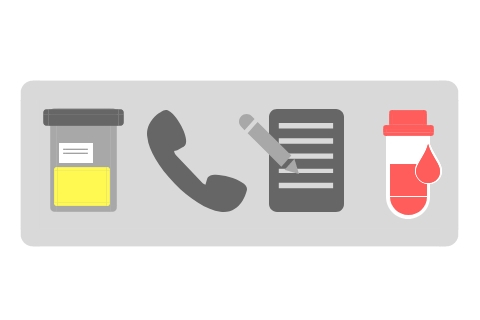Table of contents
What happens after you apply for life insurance? An employee of the insurance company—called the underwriter—reviews it in a process called life insurance underwriting.
What is underwriting, why is it so important, and how does it affect your pricing?
We’re here to break down the basics of underwriting for life insurance. You’ll learn:
- Why underwriting exists, and what are the most critical risk factors that affect it
- What kind of tests you have to go through when you apply for life insurance coverage
- Why your policy might be more expensive than what you were quoted (or why you were declined coverage)
So if you want to know what happens after you send your life insurance application, this guide is for you.
Let’s get started.
- Key takeaways:
- Underwriting allows the insurance provider to evaluate your risk, determine whether to approve your application, and decide your premium based on your risk level.
- The underwriter takes into account your health, lifestyle, and much more to calculate your risk.
- To gather more information about you, underwriters may request a doctor’s report, motor vehicle records, and other tests or documents.

What Is The Life Insurance Underwriting Process?

Life insurance is all about assessing risk.
You transfer the risk of financial loss from your death to the insurance provider. For taking on that risk, you pay a fee known as a premium.
How do insurance companies set the premium? By using an actuarial (or mortality) table. It’s a spreadsheet that estimates a person’s life expectancy based on their gender and age.
For example, a 40-year-old man has a life expectancy of 81.7 years, so he has an average of 41.7 years left to live.
Likewise, a 55-year-old woman has a life expectancy of 86.1 years, so she has an average of 31.1 years left to live.
From these actuarial tables, insurance companies can determine the proper premium to charge.
Of course, not every 40-year-old man is the same, and not every 55-year-old woman is the same. They may differ in many different ways, including:
- Smoking status
- Health
- Financial status
- Occupation
And more. That’s why you need to give so much information to the insurance provider. With the data in hand, it can differentiate you from other people and charge you the right price.
That’s what underwriting is all about.
What does the underwriter do?
The underwriter of the insurance provider compiles information about you to calculate your mortality risk. These underwriting requirements can be in the form of a doctor’s report, medical exam, driving record, and more.
It’s like solving a puzzle with each piece being some information about you. The more pieces the underwriter has, the clearer the picture he has of you.
How long does underwriting take?
The entire underwriting process can take a couple of days to over a month, but be patient! The underwriter is hard at work putting together all the information.
The time it takes to underwrite you depends on how complex your risk profile is. For example, if you have a simple medical history and are in good health, it should only take a few days to over a week to process.
However, if you have complicated health problems, the underwriter may ask for your medical records from your family doctor. It could also request you do a medical exam. These extra requirements will extend the process by at least a few weeks.
Since every insurer has different guidelines and processing speed, take these timeframes with a grain of salt.
How can you qualify for accelerated underwriting?
Accelerated (or fluidless) underwriting means you can go through the application process without a mandatory medical exam. This speeds up the underwriting process so that you can get your life insurance coverage faster. The insurance industry has developed advanced underwriting techniques to make this possible.
For example, many insurance companies let you apply for $1,000,000 of coverage if you’re 50 or under with accelerated underwriting. Some insurers have increased this limit to $2,000,000. Manulife even upped the fluidless underwriting to a maximum coverage of $3,000,000!
In most cases, underwriters have all the information it needs on the application. They don’t need additional data from an exam, like your blood pressure or blood and urine sample.
However, in some cases, underwriters can still order the medical exam if your medical history warrants it. For example, if you have a history of cancer, stroke, heart attack, or diabetes.
How about simplified or no medical underwriting?
Simplified issue and guarantee issue life insurance—also known as no medical life insurance—underwriting means that you’re guaranteed not to have to undergo a medical exam, no matter your medical history.
No medical life insurance has fewer questions on the application. Also, the insurance carrier issues the policy much more quickly. However, it tends to cost more and offers lower amounts of coverage. So there’s a tradeoff between convenience/speed and cost.
What Are The Most Important Factors In Life Insurance Underwriting?
Underwriters try to get as much personal information about you as possible to assess your level of risk. Some of the most important risk factors include your:
- Medical history
- Lifestyle
- Financial information
Let’s dive into these in more detail.
Medical history
While insurance companies prefer healthy clients, it doesn’t mean they will turn down applicants in poor health. However, they do want to ensure they charge a higher cost to account for the increased risk.
As part of medical underwriting, insurers will want to know details of your medical history, including past diagnoses of cancer, diabetes, and much more.
Here are a few life insurance underwriting questions asked on the application:
- Have you ever had high blood pressure, high cholesterol, diabetes, heart disease, or other heart and blood vessel disorders?
- Have you had any symptoms or treatment for any medical condition that resulted in hospitalization within the past 2 years?
Lifestyle
Participating in dangerous sports, drug and alcohol abuse, and poor driving history are all examples of a higher risk level than the average person. The underwriter reviews your lifestyle to determine if it should:
- Charge you the standard pricing
- Charge you higher premiums
- Decline your application
- Exclude a dangerous activity
Here are a few questions on the application related to lifestyle:
- Have you, within the past 5 years, participated in motor vehicle racing, scuba diving, hang gliding, rock climbing, backcountry skiing, or any other similar sports?
- Have you had a license suspension, DUI, or reckless driving conviction in the past 5 years?
Financial information
Unlike the two previous risk factors, this one’s impact on getting life insurance isn’t as obvious. Nevertheless, your financial information is an essential part of the underwriting process.
With financial underwriting, the insurance provider wants to know that the total amount of coverage you want to get is suitable. It doesn’t want you to be overinsured, meaning you have more life insurance coverage than you need.
Underwriters consider any existing life insurance policy you have, your annual income, and your net worth to assess risk.
For example, here are some of the questions asked on the life insurance application:
- What are your total assets, liabilities, and net worth?
- What is your annual income, both earned and unearned?
What Do Life Insurance Underwriters Look For?

Besides the questions asked on the application, underwriters can also order tests and reports to gather more data on you. The more coverage you buy and the older you are, the more information underwriters will want on you.
Here are some of the extra underwriting requirements that may be needed.
Medical exam
You can book the medical exam at a time and place that is convenient for you. During the exam, the health professional will measure the following:
- Weight and height measurement: To calculate your body mass index (BMI).
- Blood test: To test for diabetes, high cholesterol, kidney and liver function, and HIV.
- Urine sample: To test for glucose, blood, protein, medication and drugs, and cotinine (a by-product of nicotine).
- Blood pressure and pulse
Who does it and where: Health professional, at the comfort of your own home or workplace, or a medical clinic.
How long it takes: 30-45 minutes.
Electrocardiogram (ECG)
Underwriters will want you to do an ECG if you’re older and applying for a large amount of life insurance coverage. The ECG is a non-invasive procedure that measures the electrical activity of the heart.
It can detect:
- Your heart rate
- Regularity of heartbeats
- Any damage to your heart
- Symptoms of heart disease
- The position of the heart chambers
- Any effect that drugs have had on the heart
Who does it and where: Paramedical nurse or ECG technician, at a medical centre with proper equipment.
How long it takes: 20-30 minutes.
Motor vehicle report (MVR)
If you have a history of DUIs or license suspensions, the underwriter may request a driving record.
An MVR details your driving history with information about moving violations, from minor infractions such as speeding tickets to severe violations like hit-and-run and DUIs.
Who does it: The insurance company.
How long it takes: Approximately 15 days to obtain.
Attending physician statement (APS)
What if the underwriting department needs clarification on your medical history?
In this case, it calls your doctor for an attending physician statement (APS). As the official report from your doctor, it should contain your complete medical records.
The APS should help clarify the questions that the underwriter has about your health.
Who does it: The insurance company.
How long it takes: 2-4 weeks to obtain.
What Are The Results Of Underwriting?
So, now that the underwriter has all your information, it’s time for him to make a decision. He will compare it with mortality tables with a similar risk profile.
Through this process, he can determine your risk level and come up with a decision.
Here are 5 life insurance underwriting decisions that you should be aware of.
1. Approved at standard rates
The most common decision is the approval of the application at standard rates. This is the result when your health and lifestyle fall within the average of those in your age group.
The best thing about having a standard-rated policy?
There are no surprises: the premium turns out to be what you were quoted.
2. Approved with preferred rates
If your health and lifestyle are better than the average person’s, you could end up with an insurance policy with a preferred rate. With preferred rates, you pay up to 30% less on the cost of life insurance coverage. Check out our post on preferred rates for more information on how you can qualify for the savings.
3. Approved at substandard rates
Conversely, if underwriters determine that your risk level is higher than the average person’s, it will charge you more for your insurance policy. The extra premium is known as a rating, ranging from 25% to 400%, depending on the risks of insuring you.
4. Declined
Sometimes, insurance companies will determine that you’re too much of a risk to insure, even if it charges higher premiums. In this case, it will pass on insuring you. Find out what you can do if you’re declined for life insurance coverage in this post.
5. Postponed
Finally, the insurance company can postpone your application for life insurance. This means that it’s not ready to offer you life insurance at the moment.
Why? Maybe you are awaiting the results of a medical test that you just completed. Or maybe you have a routine test scheduled, and the underwriter would like to see the results before making a decision.
Still Have Questions About Underwriting?
We know that underwriting for life insurance can be a complex topic to understand. That’s why we work with our clients throughout the process to keep them updated on their applications. That way, there are no surprises when they get their policies.
Contact us today if you would like to know how you can benefit from a smooth and stress-free underwriting process.
Get Your Life Insurance Quote Now
While we make every effort to keep our site updated, please be aware that timely information on this page, such as quote estimates, or pertinent details about companies, may only be accurate as of its last edit day. Brian So Insurance and its representatives do not give legal or tax advice. Please consult your own legal or tax adviser. This post is a brief summary for indicative purposes only. It does not include all terms, conditions, limitations, exclusions, and other provisions of the policies described, some of which may be material to the policy selection. Please refer to the actual policy documents for complete details which can be provided upon request. In case of any discrepancy, the language in the actual policy documents will prevail. A.M. Best financial strength ratings displayed are not a warranty of a company’s financial strength and ability to meet its obligations to policyholders.


If a case is declined in view of medical such as TMT findings
Can we take lifeinsurance if a case is declined for tmt findings
A TMT isn’t done to detect early heart problems. That comes later, generally to confirm issues. You see, you could have issues now, and “pass” a TMT. Try a NST. Sometimes there are false pos and sometimes false negs, but it’s a good start. The gold standard is still a cardiac catheterization, which shows the full “tree,” and if there are any blockages, or valvular issues, they will show up in the angiography. Remember what is the concept of insurance, as it applies to spreading the risk, within a group of insureds. Obviously, at 70, you may not be the same as 35, but the rates take care of that. And 70-year-olds don’t get the same coverage as those a lot younger. 25 years in the insurance industry.